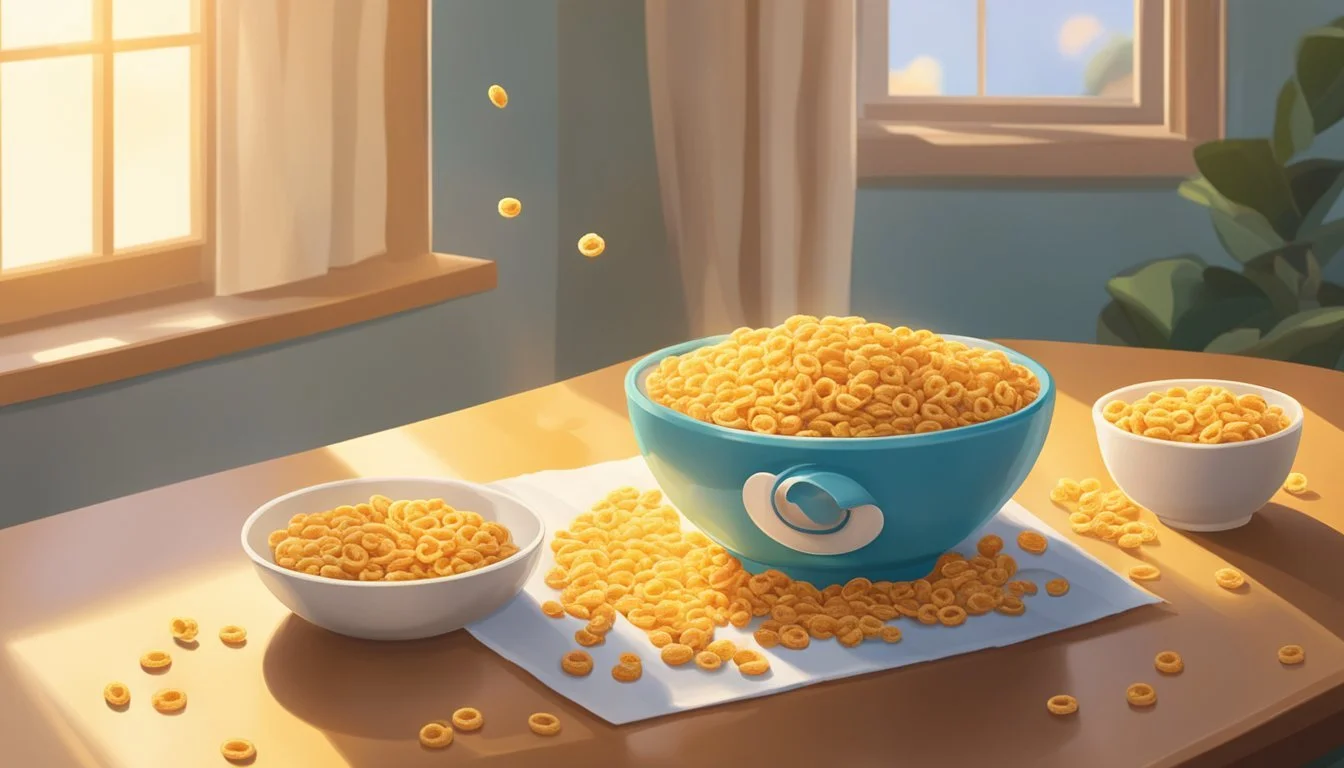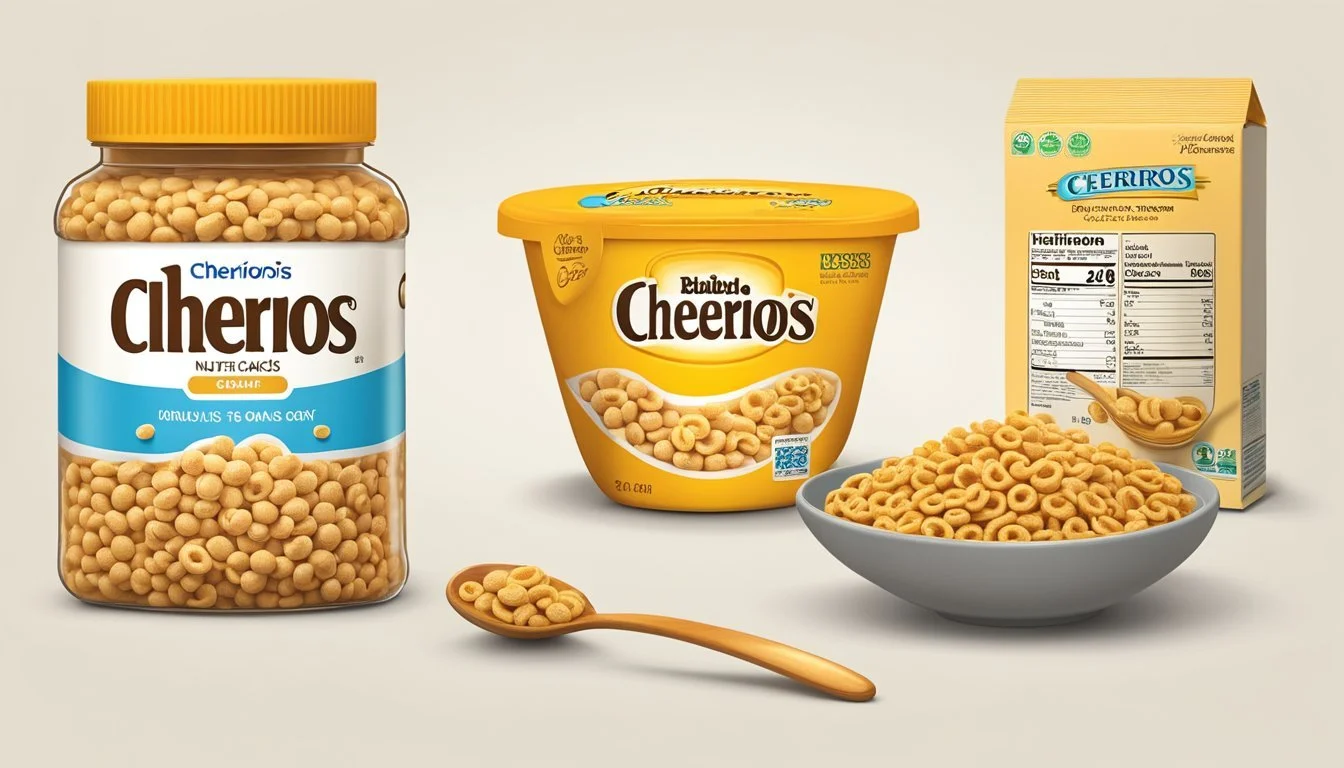Cheerios vs Honey Smacks
Nutritional Comparison and Taste Analysis
This Article is Part of Our Breakfast Cereal Guide with Details on Cheerios Nutrition and Honey Smacks Nutrition
Deciding between General Mills Cheerios and Kellogg's Honey Smacks for breakfast often comes down to health benefits and personal taste preferences. Cheerios offers 17 grams of complex carbohydrates per serving, providing a steady release of energy, making it a staple for those seeking a heart-healthy start to their day. On the other hand, Honey Smacks, despite its appealing sweet taste, contains only 9 grams of complex carbohydrates and notably higher sugar content, which might not be ideal for those monitoring their sugar intake.
When comparing the nutritional highlights, Cheerios stands out with higher values in essential nutrients like Iron, Zinc, Folate, and various vitamins, contributing significantly to daily nutritional needs. Conversely, while Honey Smacks is rich in Vitamin B2, it falls short in these critical nutrients, which can make a difference in your overall health maintenance.
Ultimately, for individuals focused on balancing their diet, Cheerios emerges as the healthier option due to its nutrient-dense profile and lower sugar content. However, for those who prioritize flavor and don’t mind a sweeter start to their morning, Honey Smacks might still hold its charm.
History and Manufacturers
Cheerios and Honey Smacks are both iconic breakfast cereals with rich histories. Each cereal was developed to cater to consumer preferences and has undergone significant changes over the decades.
Origins of Cheerios
Cheerios was introduced by General Mills in 1941 under the name CheeriOats. The cereal aimed to provide a nutritious breakfast option based on whole grain oats.
In 1945, the name was shortened to Cheerios to simplify marketing. The round, oat-based cereal quickly gained popularity due to its simple ingredients and appealing texture.
Through the decades, Cheerios expanded its product line with variations like Honey Nut Cheerios in 1979, meeting growing demand for flavored cereals. General Mills continues to innovate, keeping Cheerios relevant in a competitive market.
Origins of Honey Smacks
Honey Smacks, originally launched by Kellogg's in 1953, was initially named Sugar Smacks. This cereal was developed to appeal to children by offering a sweet, puffed wheat product.
In response to growing health concerns in the 1980s, Kellogg's rebranded the cereal as Honey Smacks to highlight its use of honey as a sweetener, though the sugar content remained high.
Subsequent decades saw further tweaks in the name and recipe, reflecting evolving consumer tastes and nutritional awareness. Honey Smacks still maintains a loyal following, successfully capturing a niche in the sugary cereal segment.
Nutritional Profiles
Cheerios and Honey Smacks offer contrasting nutritional benefits and drawbacks. They differ significantly in terms of calories, macronutrients, vitamins, minerals, sugar, and sodium.
Caloric Comparison
Cheerios provide approximately 100 calories per serving, while Honey Smacks have 130 calories for a similar serving size. The difference in calorie content can be attributed to the ingredients and sugar levels used in each cereal.
Macronutrients and Fiber
Cheerios contain 2 grams of protein per serving compared to Honey Smacks' 2 grams. Fat content: Cheerios have 2 grams per serving. Honey Smacks have 0.5 grams. Dietary fiber: Cheerios contain about 3 grams per serving, contributing to better digestive health. Honey Smacks have less dietary fiber.
Vitamins and Minerals
Cheerios have a robust profile of essential vitamins and minerals. They are particularly high in iron, zinc, calcium, and several B-vitamins such as B12 and B6. Honey Smacks, on the other hand, offer more Vitamin B2 but lack many other essential nutrients.
Sugar and Sodium Content
Cheerios have 1 gram of sugar per serving, whereas Honey Smacks contain 18 grams of sugar, making them far sweeter. Sodium levels are also higher in Cheerios, with 290 milligrams per serving compared to Honey Smacks' 70 milligrams.
In summary, Cheerios are more nutrient-dense, with higher vitamins and minerals, while Honey Smacks are higher in sugar and calories, making them less suitable for those monitoring their sugar intake.
Ingredient Analysis
This section breaks down the main components of Cheerios and Honey Smacks, specifically focusing on their primary ingredients, sweeteners, flavors, and artificial additives found in each cereal.
Main Ingredients
Cheerios primarily consist of whole grain oats, which offer substantial dietary fiber and essential nutrients. Oats are known for their benefits such as reducing cholesterol levels due to their soluble fiber content.
Honey Smacks mostly feature sugar-coated puffed wheat. Unlike Cheerios, which focus on whole grains, Honey Smacks prioritize a sweet flavor profile. Wheat is a source of essential vitamins but doesn't provide the same level of fiber as oats.
Overall, the fundamental difference lies in the choice of grains used, with Cheerios favoring fiber-rich oats and Honey Smacks opting for wheat, leading to a distinct variation in their nutritional profiles.
Sweeteners and Flavors
Cheerios incorporate sugar in moderate amounts and use natural flavors to maintain a mild taste. The heart-healthy reputation of Cheerios is partially due to their low sugar content, making them a preferred option for those monitoring their sugar intake.
Honey Smacks are characterized by a significantly higher sugar content. They utilize honey and corn syrup as primary sweeteners. This results in a sweeter taste and higher overall sugar levels per serving.
In summary, while Cheerios keep sugar content to a minimum, Honey Smacks' reliance on honey and corn syrup makes them considerably sweeter.
Artificial Additives
Cheerios strive to avoid artificial colors and flavors, sticking predominantly to natural ingredients. This aligns with their branding as a healthier cereal option.
Honey Smacks, on the other hand, may include artificial colors, contributing to the vibrant appearance of the cereal. The inclusion of these additives is more aligned with their sweet and visually appealing market positioning.
The presence of artificial additives in Honey Smacks contrasts with Cheerios' emphasis on natural ingredients. This difference is crucial for consumers who are mindful of artificial substances in their diet.
Health Considerations
Cheerios and Honey Smacks offer different health benefits and potential concerns. While Cheerios provide more complex carbohydrates and essential nutrients, Honey Smacks have a higher sugar content, which impacts their overall healthiness.
Impact on Diet and Nutrition
Cheerios contain 17.0 grams of complex carbohydrates per serving compared to Honey Smacks, which have 9.0 grams. Cheerios also offer significant amounts of Iron, Zinc, Folate, Vitamin B12, and Calcium, among other nutrients. This makes them a good option for those seeking a nutrient-dense breakfast.
Honey Smacks, on the other hand, have a higher sugar content, contributing to higher caloric intake and potential weight gain. For individuals focusing on heart health, Cheerios might be a better choice due to their lower fat and higher fiber content, which can aid in cholesterol management.
Allergens and Sensitivities
Both cereals contain ingredients that may pose allergen risks. Cheerios are made from whole grain oats but may include traces of wheat due to processing, which could affect those with gluten sensitivities or celiac disease. Honey Smacks contain wheat and could trigger allergic reactions in those sensitive to gluten or wheat.
It's important to review ingredient lists for potential allergens such as nuts, dairy, and soy. Cross-contamination during manufacturing also poses a risk for those with severe allergies, making it essential to check packaging for allergy information.
Suggestions for Health-Conscious Consumers
For those looking to maintain a healthy diet, opting for Cheerios over Honey Smacks could be more beneficial due to their higher nutrient content and lower sugar levels. They are an excellent choice for a healthy breakfast.
Incorporating dietary fiber-rich foods like Cheerios can support weight loss and improve digestion. Health-conscious consumers should also be mindful of portion sizes. While Honey Smacks might be appealing for their sweetness, their sugar content should be considered carefully, particularly for people managing their weight or blood sugar levels.
Market Position and Consumer Preferences
This section focuses on the market position of Cheerios and Honey Smacks in the breakfast cereal industry, delving into popularity trends, consumer reviews, and serving size and frequency.
Popularity Trends
Cheerios, a product of General Mills, has consistently held a strong market position in the United States. Honey Nut Cheerios is especially popular, ranking as the third top-selling cereal brand. This popularity is partly due to its diversification into various flavors such as Cheerios Oat Crunch.
Honey Smacks, on the other hand, is produced by Kellogg's and has a dedicated but smaller following. Their high sugar content makes Honey Smacks appealing to children, but they lag behind Cheerios in terms of overall market share. Cheerios also capitalizes on the growing demand for healthier breakfast options by offering Multi-Grain and Apple Cinnamon varieties.
Consumer Reviews
Cheerios generally receive favorable reviews for their versatility and nutritional value. Many consumers appreciate the variety of flavors available, catering to both health-conscious adults and families. Reviews often highlight the balance of taste and nutritional benefits such as high fiber content from whole grain oats.
Honey Smacks, while enjoyable for their sweet taste, often face criticism for higher sugar content and lower nutritional value. Despite this, they maintain a loyal customer base among those seeking a sweeter breakfast option. Opinions here are mixed; some love the crispy texture and sweetness, whereas others find it too sugary for regular consumption.
Serving Size and Frequency
Cheerios: A standard serving size for Cheerios is typically 1 cup, containing about 100 calories. Consumers of Cheerios often have it daily as part of a balanced diet due to its lower calorie and sugar content. This makes it a staple in many households.
Honey Smacks: The serving size for Honey Smacks is generally 3/4 cup, providing around 110 calories but significantly higher sugar levels. Given this, Honey Smacks are less frequently consumed as a daily breakfast and more often as an occasional treat.
Cheerios is positioned as a healthier choice suitable for regular consumption, whereas Honey Smacks appeal more to taste preferences but at the expense of higher sugar intake.
Comparative Analysis
Cheerios and Honey Smacks each have unique nutritional profiles and consumer preferences. This analysis explores their comparison to other popular cereals and current consumer trends.
Against Other Popular Cereals
When comparing Cheerios and Honey Smacks to other cereals such as Lucky Charms, Cinnamon Toast Crunch, and Frosted Flakes, some distinct differences emerge. Cheerios is known for its higher iron and fiber content, while Honey Smacks has high sugar levels. For those watching their calorie and sugar intake, Cheerios is a better choice.
In contrast, cereals like Reese's Puffs and Cocoa Krispies may appeal more for taste but fall short on nutritional benefits. Shredded Wheat and Raisin Bran are other healthier options that emphasize fiber and whole grains. Both Kellogg's Corn Flakes and General Mills Cheerios serve as great options for those seeking low sugar, gluten-free alternatives.
Consumer Choices and Trends
Consumer trends indicate a shift towards healthier cereals. Cheerios, for instance, has gained traction for its high vitamin and mineral content, especially iron, zinc, and folate. In comparison, Honey Smacks has been criticized for its high added sugar levels, making it a less health-conscious choice.
Moreover, cereals fortified with additional nutrients such as Honey Bunches of Oats and Life Cereal are increasingly popular. Consumers also show interest in cereals that are gluten-free or have natural ingredients, avoiding those high in refined sugars and salt. Milk paired with any cereal significantly boosts calcium and protein intake, making it a vital aspect of daily nutrition habits.




